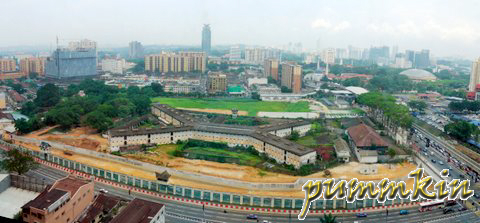
Birds-eye view of the prison wall surrounding the prison.
Hardly anything was mentioned about the people who painted the mural of the now, demolished Pudu Prison Wall. On the night of the 21 June 2010, these walls that once held the regal paintings of scenes from a convict’s captive imagination of the jungles & streams from his younger days, came tumbling down to make way for a wider road. Ironically, nothing much had been said about the soon-to-be demolished former prison that once held 6,550 inmates requiring them to take sleep shifts in 240 cells over the years since it was built in 1895 until yesterday when UDA announced the plans for a mixture of commercial & residential project over the site.

The mural of the jungle & waterfall that’s left on the day of demolition.
In the 1980’s, there would be a man, with buckets of paints, preparing to spread the wall with a white emulsion. I watched in fascination as daddy sends us to school & most often we get stuck in traffic along Jalan Pudu. The earth-coloured walls would take on panel by panel of white paint, much like what the art teacher taught us to lay down a foundation before your work of art goes onto the paper. Over the weeks, these white walls were soon taking on a greenish hue, multi-tones of turquoise & stops where the outline of what seemed to be tree trunks, took place. As the branches were drawn, I could only imagine that the artist was painting a jungle – totally befitting of how the area derived its name from. Pudu in Cantonese is called Pun San Par, meaning ”˜half jungle.’ With my windows down, I would watch this artist accompanied by a uniformed watchmen, with fascination as he laid the intricacies of the mural with his fingers & hand! He paid no attention to the buses & vehicles plying the route & went on to paint from morning till whenever. This stretch of 394m vertical facade made the entry to the Guinness Book of World Records for the longest mural on earth. Week by week, the walls transformed into a beautiful work of art that was vibrantly standing in the heart of the Golden Triangle.

Sceneries of the beach & seaside was also captured on the Jalan Hang Tuah’s section of the wall.
Although several people worked on this mural according to Helen Ang who wrote in the NST on April 21, 1994, only one person (Khong Yen Chong) got the recognition for it. This is what she wrote in a blogpost recounting the article:-
Let me share with you something I wrote in NST on April 21, 1994. It’s about ex-convict Pha Tee, the man on crutches with one leg amputated. A former drug addict, Pha had been in and out of jail most of his adult life, serving his first term in 1963 and last released 1990. His daughter recalled she sometimes saw her father painting the Pudu mural when she passed by the prison; “I wished then that I could have stopped and talked to him.”
In the photo, the right side of Pha’s jaw is swollen ”“ “due to an infection which began when a fish bone stuck in his gum. In an attempt to cure the ailment he had extracted several of his teeth, using a string to pull them out”.
Pha earned his living through menial work, scavenging cables and electrical wires from abandoned buildings or collecting scrap metal.
According to Pha, the other artists who worked on the mural ”“ and whom he remembered ”“ were Khong Yen Chong, Cheng Tai Cheng, and Lee Kim Seng.
At the time I interviewed him in 1994, Pha said he’d painted murals on a block of flats in Jalan Pandan, another on a fence in a back lane behind Jalan Talalla, hotel in Perlis and factory in Terengganu.
As for my article headline; Pha said covering the prison walls with scenes from his captive imagination allowed him to remember the jungles and streams from his younger days, and gave him a transient feeling of ”˜freedom’. “We worked outside from morning until early afternoon but the guard was always there, and so you always knew you had to go back inside.”
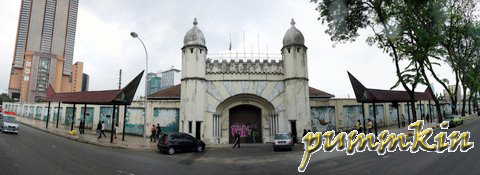
The main gate of the prison.
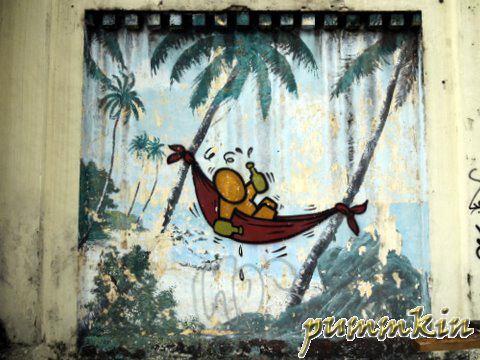
Someone had a sense of humour when this was drawn. No, it’s not part of the original mural.
When I got news of the demolition, I got hold of Aziz, my neighbour, to accompany me to get the last shots of this place. Although some of the panels had been tainted with graffiti, I was just glad to save a piece of history for my own recollection in later years. We ran across to the road divider as well as the nearest monorail station to try to get the best shots & left no holes un-ferreted. Aziz said that there used to be a little hut on Jalan Hang Tuah right beside the prison where they used to sell the handicrafts & goods made by the inmates. That hut is no longer there but the memory lives on.
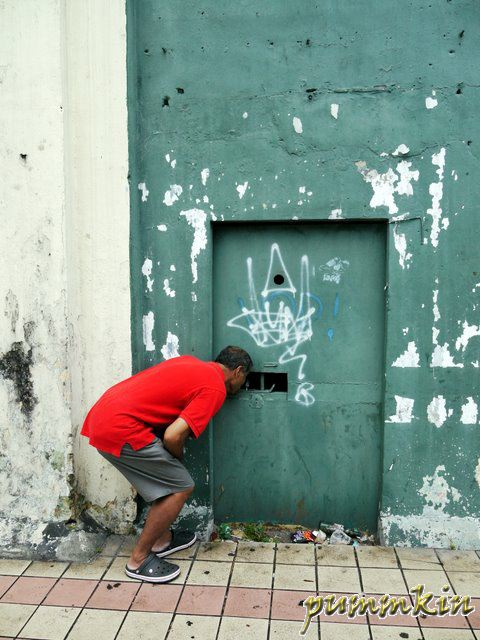
Aziz peering through the hole in the tiny metal door.

Locks that secured this door.
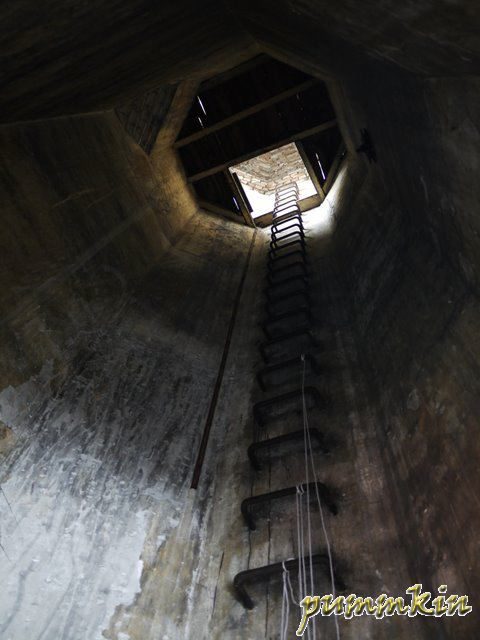
The Watch Tower on the main gate. I was really tempted to climb it.
I could only imagine the hope of Pha Tee in being free to see the place that he held so vividly in his imagination that translated into this work that’s now demolished. It must have been this hope, that sets him apart from the rest for being able to set foot outside the prison for months. I wish all the artists who contributed to this fantastic piece of history, would lead new lives after they have served their term.
I bet if Pha Tee is still alive, he might not remember the pudgy girl who constantly yelled from her daddy’s car window, but he would surely remember hearing “Cover that section of the tree!” or “Cover this section of the grass!”… whenever the car stopped at where he was smudging!
This is really interesting take on the concept. I never thought of it that way. I came across this site recently which I think it will be a great use of new ideas and informations.
Thanks for posting your link on the FB group page!
There is not a parking lot, so you will need to park on the side of the road and walk down the steps.
This particular membership has been around for 22 years and has a solid reputation. The best-known and the largest rainforest in the
world is the Amazon Rainforest.